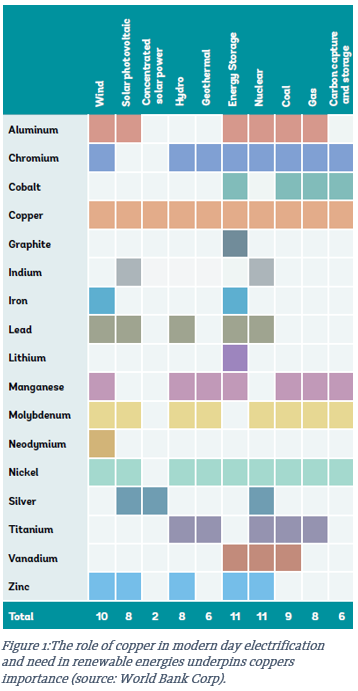Copper Deposits and Characteristics
Copper plays an integral role in modern life through its role in everyday infrastructure—a role that is set to increase as the need for renewable energy rises (figure 1). It is estimated that a shift to green energy will require significantly more copper than conventional power generation methods. For example, almost three times more copper is required for electric vehicles compared to conventional vehicles. The importance of this is the global demand for copper is poised to exceed supply in the future driving the price of copper. This rational is the basis for our long-term copper thesis which coincides with a tightening supply due to lack of discoveries (20 years required to advance a project from discovery to production). These factors will affect the long-term copper pipeline and, in turn, provide a favourable outlook for the commodity price going forward.

Copper mineralization occurs in many forms and different geological settings but is largely dominated by porphyry copper deposits. Currently, Chile is the world’s leading copper producer followed by Peru and China. Not surprising, the world’s largest copper deposit is in Chile—the Escondida mine which has close to 6 billion tonnes (Bt) of mineable ore at 0.64% Cu and an additional 10 Bt at 0.50% Cu that could also be mined in the future. The global average is approximated to be 500 Mt at 0.62% copper.
Porphyry deposits are typically polymetallic either copper-molybdenum or copper-gold and usually have a silver credit. The western coasts, North and South America, are where the majority of deposits are found due to converging tectonic plates. At these subduction zones, heavier and denser oceanic plates are forced down under continental plates (lighter due to mineral composition) into the asthenosphere where the plate begins to melt causing magma to rise up through the crust. As discussed in our earlier outlook, the rising magma leaches elements from the surrounding rock concentrating them in the rising magma only to be deposited at a certain depth. The deposits are classified as porphyries because of the texture of the rock. As the magma rises, different minerals precipitate out of solution due to differential cooling which creates larger crystals within a finer grained groundmass. The main copper mineral associated with these deposits is chalcopyrite (CuFeS2) which contains about 34.5% Cu.
“This means that” porphyry deposits account for 60-70% of global copper production and as demand increases new deposits must be found, namely porphyries, to replace the current pipeline. The ongoing shift to renewable energy and electrification is a clear indication of the importance copper will play in the future and hence the companies seeking to find new deposits.
National Instrument 31-103 requires registered firms to disclose information that a reasonable investor would expect to know, including any material conflicts with the firm or its representatives. Doug Johnson and/or Pathfinder Asset Management Limited are an insider of companies periodically mentioned in this report. Please visit www.paml.ca for full disclosures.
*All returns are time weighted and net of investment management fees. Returns from the Pathfinder Partners’ Fund and Partners’ Real Return Plus Fund are presented based on the masters series of each fund. The Pathfinder Core: Equity Portfolio and The Pathfinder Core: High Income Portfolio are live accounts. These are actual accounts owned by the Pathfinder Chairman (Equity) and client (High Income) which contain no legacy positions, cash flows or other Pathfinder investment mandates or products. Monthly inception dates for each fund and portfolio are as follows: Pathfinder North American: Equity Portfolio (January 2011), Pathfinder North American: High Income Portfolio (October 2012) Pathfinder Partners’ Fund (April 2011), Pathfinder Real Return Plus Fund (April, 2013), Pathfinder International Fund (November 2014) and Pathfinder Resource Fund (May 2018).
Pathfinder Asset Management Limited (PAML) and its affiliates may collectively beneficially own in excess of 10% of one or more classes of the issued and outstanding equity securities mentioned in this newsletter. This publication is intended only to convey information. It is not to be construed as an investment guide or as an offer or solicitation of an offer to buy or sell any of the securities mentioned in it. The author has taken all usual and reasonable precautions to determine that the information contained in this publication has been obtained from sources believed to be reliable and that the procedures used to summarize and analyze such information are based on approved practices and principles in the investment industry. However, the market forces underlying investment value are subject to sudden and dramatic changes and data availability varies from one moment to the next. Consequently, neither the author nor PAML can make any warranty as to the accuracy or completeness of information, analysis or views contained in this publication or their usefulness or suitability in any particular circumstance. You should not undertake any investment or portfolio assessment or other transaction on the basis of this publication, but should first consult your portfolio manager, who can assess all relevant particulars of any proposed investment or transaction. PAML and the author accept no liability of any kind whatsoever or any damages or losses incurred by you as a result of reliance upon or use of this publication.